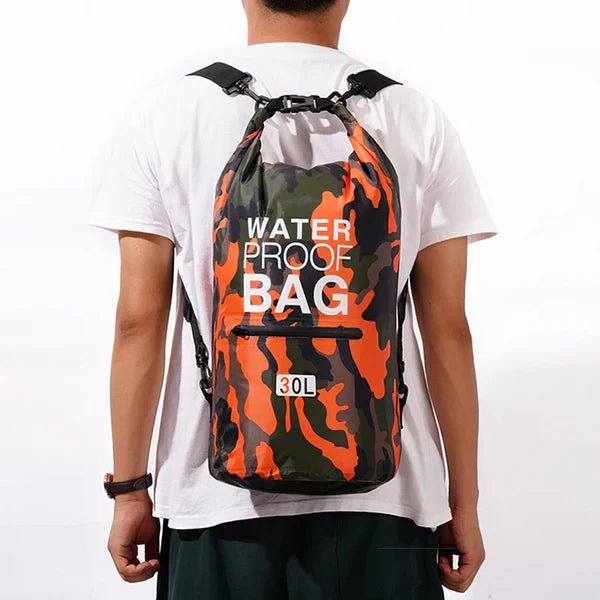
Are Dry Bags Really Waterproof? Here's What You Need to Know Before Your Next Adventure.
Share
Introduction: The Dry Bag Debate
You’re packing for your kayaking trip, a long hike, or maybe just a beach day with the kids. You’ve got your essentials—phone, wallet, dry clothes—but the looming question is: Will your dry bag actually keep them dry? A lot of people wonder if dry bags are truly waterproof, or just “water-resistant.”
In this blog, we’ll unpack the truth behind the waterproof promise and why the right dry bag, like our 30L or 15L model, really can make or break your next adventure.
Understanding What 'Waterproof' Actually Means
First off, let’s clear up the term “waterproof.” Many brands throw it around, but it doesn’t always mean what you think. Waterproof means water cannot enter the bag at all, under normal usage—rain, splashes, or even brief submersion.
In contrast, “water-resistant” usually means it can handle some moisture but not full-on wet conditions. The question is: does your bag seal tight enough to survive a drop in the river or a surprise rainstorm?
How Dry Bags Keep Water Out
A true waterproof dry bag is made from high-denier materials like PVC or TPU, and built with seam-welded construction—not stitching. These materials are both tough and waterproof on their own.
But the real magic happens at the opening.
Most waterproof dry bags use a roll-top closure system. Here’s how it works:
- You fold the top of the bag over itself 3–5 times.
- You snap or clip the ends together.
- This creates a tight seal that prevents water, dust, and even sand from entering.
This design creates a watertight chamber, especially when the bag is not overfilled.
Are Dry Bags Really Waterproof?
In short: yes—if it’s the right bag and you’re using it correctly.
High-quality bags (like your product line) are tested under various conditions—rain, wave splashes, and full submersion—for short periods. They’re designed for kayakers, paddle boarders, hikers, beach-goers, and travelers who need absolute protection.
If a dry bag leaks, it’s often because:
- It’s made with poor stitching (not heat-sealed)
- It was overfilled and couldn't seal properly
- The roll-top wasn’t folded tightly
With proper use, you can confidently carry electronics, clothes, snacks—even camera gear—without worrying.
How to Use a Dry Bag Correctly
Using a dry bag isn’t rocket science, but there is a technique involved:
- Don’t fill it to the brim—leave some space at the top
- Roll the top at least 3 times before clipping
- Squeeze gently to test for air tightness
Many people treat their dry bags casually and then blame the gear when something gets damp. A properly sealed dry bag should feel almost air-filled, like a balloon.
Can You Submerge a Dry Bag?
Technically, yes—but most dry bags are designed to float, not sink. The air trapped inside adds buoyancy, which means if your kayak tips or your boat flips, your gear won’t end up at the bottom of the lake.
That’s the real beauty of a waterproof dry bag—it doesn’t just repel water, it floats with your belongings still safe inside.
Best Use Cases for a Waterproof Dry Bag
Dry bags are ideal for:
- Camping and hiking: Store dry clothes, matches, or food
- Beach days: Keep towels and phones sand-free
- Kayaking or paddleboarding: Strap it to your board for snacks or a change of clothes
- Travel: Use it as an extra dirty laundry bag or backup daypack
- Commuting: Rainy day? Toss your laptop in one and walk worry-free
Why Size Matters: 15L vs 30L
A 15L dry bag is perfect for essentials—a phone, shirt, water bottle, and some snacks. Great for light activities and day hikes.
The 30L bag fits a full outfit, shoes, towel, and more. Ideal for beach days, kayaking, or short weekend trips. Both sizes are lightweight, roll easily, and fit into larger backpacks if needed.
Real User Reviews Tell the Story
“I dropped my dry bag in the lake, and when I got it back, everything—my phone, my wallet, even a paper notebook—was completely dry. 10/10.”
“Took it hiking in Scotland. Rain all day. My backup clothes were the only dry thing on me when I reached the hut.”
Conclusion: Choose the Right Bag, Use It Right, Stay Dry Every Time
So, are dry bags waterproof? Absolutely. When you pick a high-quality design like ours and seal it correctly, your gear is protected—even in rough conditions. Whether you’re heading out on a kayak, hiking up a soggy trail, or traveling in unpredictable weather, a waterproof dry bag is a non-negotiable piece of gear.
Don’t let moisture ruin your adventure—pack smart and dry every time.
